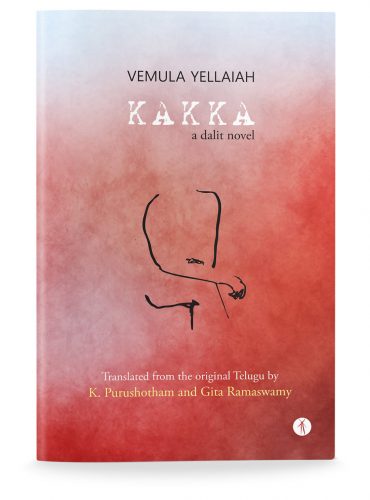Vemula Yelliah’s Kakka novel basically deals with the socio – economic conditions of Madiga subcaste of Dalit community based in the newly formed state of Telangana. The death of a member in the family of the author results in the writing of this novel.
This makes it that much more authentic and powerful. Facts are laced into powerful story. It echo’s the heart beats of real-life insults, suffering, neglect, deception, exploitation of living persons over decades and centuries.
Kakka is the name of the hero of this novel. The climax of Kakka’s story happens when he is all set to play the lead role of the mythological Asura king, Mahishasura. Madigas believe that they are the descendents of the mighty Asura kings Jambavantha and Mahishasura. Jambu purana talks about Jambavantha as the ruler of Jambu dweepa. Jambu purana is one of the eight Puranas of Hindu religion.
These is also an interesting account in Wikipedia that Jambudwip is an isolated island in the Bay of Bengal, about 8 Kilometers to the southeast of Sagar Island and almost same distance to the southwest of Frazergonj, in the South 24 –Parganas District of West Bengal. Transient fishing community has been using a small part of this island from October to February every year since 1955 for fish drying as a traditional livelihood activity. The island was uninhabited, and these fishermen always go back to their natal villages – mostly in the same district – at the end of the fish-drying season. Forest Department collected revenues, fees etc. and issued permits every year till 1998. Thus, these fishermen have been enjoying an uninterrupted customary right on the island. In August – September 2002 the forest department burned down the fishing implements that the transient fishers left in the island in huts – at the end of the fishing season (2001 –2002) – and debarred the fishermen from entering into the island in October 2002. According to the Forest Department this “eviction” has been done in compliance with the Supreme Court verdict of 1996 to remove all encroachments from reserved forest.
There you have the mythology, history and geography of Jambu Dweepa. Such anomalies are more glaring in other seven Puranas and Ramayana and Bhagavatha of Hindu religion.
Madiga subcaste of AP and Telangana is the equivalent caste of Chakkalias in Tamilnadu, Chambavs in Maharastra and Chamars in north India. They are one of the sub castes which are listed as scheduled castes in Schedule castes Order 1950 of the Constitution. Madigas acquired greater prominence after the Madiga Dandora Movement started in 1994 in AP before it was bifurcated into Telangana and AP in 2014.
Discrimination and exploitation on the basis of caste in India, colour in the Western countries (particularly USA), class and sex all over the world are well known. But in India the Dalits are exploited and humiliated on the twin counts of caste and class. Dalits are at the bottom of heap in economic status and are on the lowest step of the ladder of caste system. Because of this double disadvantage, we expect the champions of the poor to be champions of the cause of the victims of caste discrimination. Vemula’s greatest concern is that it is not so. We expect that a communist should fight the caste discrimination with the same concern and vigor as Phule and Ambedkar did. But it has not happened from the time of Dange, who was the tallest leader of the communist party. Communist party later split into different groups under different nomenclatures on the basis of their degree of belief about the role violence in fighting the capitalist policies of the Govt in power. Unfortunately the ladder syndrome of left parties is almost similar to the caste ladder. The top positions of power in all leftist parties are occupied by the non dalits. Not many of them have the personal experience, knowledge and understanding of the realities of caste discrimination. So they think the single issue of their agenda and struggle should be class exploitation. Is it their simple failure or is it by design. People like Vemula believe that it is not mere a failure. He thinks that their caste genes dominate the class genes. He explains this through the character of Venkat Reddy Patel who claims that he is a communist and that he fought against the Nizam. Venkat Reddy Patel names his son as Viplav Reddy to support his claim that he is a communist. Viplav in Telugu means Revolution. Conveniently Venkat Reddy and his son live in the city while Madigas get beaten, tortured and killed by the Razakars in the villages when they revolt against Nizam. But when Nizam rule is taken over by the British, it is Patels who occupy the lands of the Nizam. The Patels don’t even allow the Madigas to take soil from the anthill for their ceremonies. They pay low wages, use abusive language and beat up Madigas. They incite Sudras against the Madigas.
It is these acts that drive Kakka and his fellow Madigas to stand up. They try to enact the Mahishasura street play to unite and embolden the Madigas to fight like Mahishasura, who supposed to have conquered the three worlds. But before the play is enacted, the Patels kidnap Kakka, who was to play the lead role of Mahishasura, and cut his calf muscles.
The novel succeeds in portraying the tyranny and the intrigues of landlord, Venkat Reddy, the double standards of communist cadres and the details of endless and unbearable physical and mental suffering of Madigas. It ends on a positive note of Kakka sensitizing the Government officers about all those things when they come for an enquiry based on a complaint given by an educated scheduled caste youth of the neighboring village.
Vemula wrote the novel in a rare and difficult colloquial Telangana Madiga Telugu genre. Dr.Purushotham and Ms.Geeta Ramaswamy have taken great pains to translate it into English in a simple and flowing style.
*









Wonderful review on the novel
Kakka.
Thanks to sri kaki madhav rao garu.and congratulations to writer& translators.
—Dr.Laxmi varaprasad. Kanety
HANAMKONDA. 506004
Wonderful review and explanation by Kaki Madhava rao. Once again congratulations to Vemula Yellanna.